By Gary Holland
Tynemouth is a place that is steeped in history. The town has seen invasions by the Romans and Vikings, two World Wars, a Civil War, the Reformation during the reign of Henry VIII and has had settlements going back to the ancient Britons and the Stone Age. Two previous Penbal posts have discussed the meaning of the name of the village and the name of the river, but in the written age, what is the first mention of the town of Tynemouth? This post highlights the earliest records of the name.
The map presented below shows towns and rivers throughout Britain with their respective Saxon place names. Written in Old English, the map shows a rare spelling of Tynemouth, ‘Tinan Muð‘ which includes the long gone letter ‘eth’ denoted by the character ð. Today, the letter ð has long since disappeared from our alphabet and instead we describe the sound using ‘th’. The Tyne is named ‘Tinan’ because of the dative case in Old English, where –an is added to nouns to indicate the recipient of an action, in this instance meaning: that which ‘dissolves’ or ‘disperses’.
As well as Tynemouth, the map also shows other local descriptions such as Bebbanburh (Bamburgh) and Dunholm (Durham). The map in these pictures, Britannia Saxonica, despite having ancient spellings, is only around 300 years old (M Burghers, 1720) and it would have, more than likely, originally been part of a book.

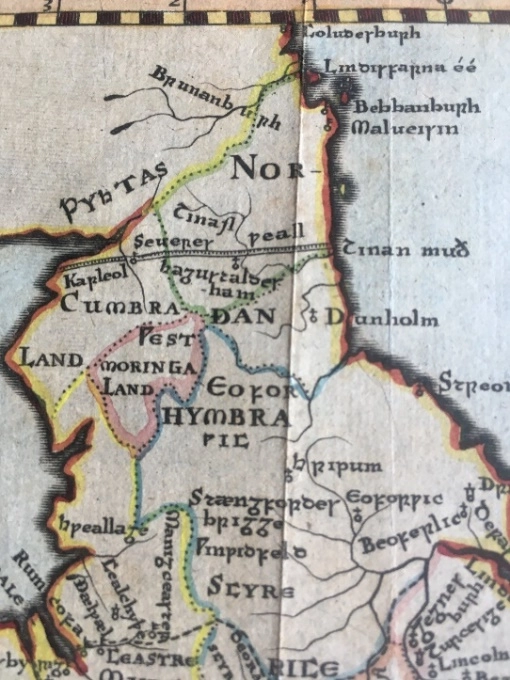
The Northumberland Assizes Roll of 1225 will also likely reference Tynemouth, as will the Tynemouth Chartulary of 1320 (held at Alnwick Castle) but a full digital version of either was unavailable at this time. For further information, Penbal discusses excerpts of the Tynemouth Chartulary in the following post.
An older mention of Tynemouth is captured in the Anglo-Saxon Chronicle. The Chronicle is essentially not one single document, but variations of differing copies created through the 8th to 12th centuries at different locations. Written in Old English, on parchment, they are an extremely important set of documents and a bridge between the Roman and Norman periods. There are only a few hundred documents in existence that are written in Old English so it’s fascinating that they have survived for so long.
In the Anglo-Saxon Chronicle, the spelling of Tynemouth is slightly different, spelled as ‘Timan Muðe’. This appears as an entry for the year 792 (British Library Cotton MS Tiberius B IV, f26v) describing the body of King Osred being at Tynemouth. (The entry for just two years later, 794, describes a Viking raid on Jarrow). This version of the Chronicle is thought to have been written in around the 11th century. In the screenshot below I’ve highlighted Tynemouth in yellow and for interest, Northumbria in green.
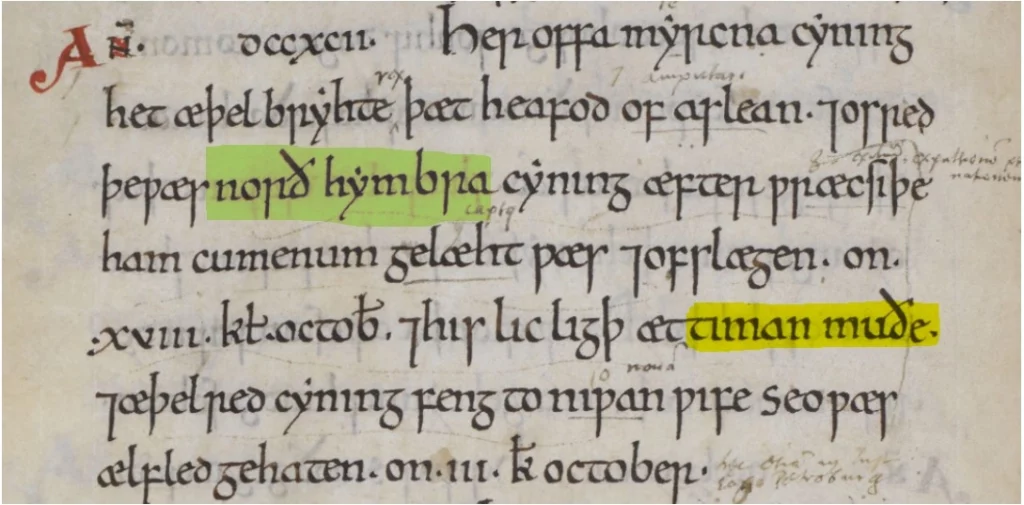
The Old English text is as follows:
An dccxcii Her offa myrcena cining
het Æðelbrihte þet heafod ofslean, 7 Osred
þe wæs Norþanhymbra cining æfter wræcsiðe
ham cumenum gelæht wæs and ofslagen. on.
xviii. kt Octob, 7 his lic ligð æt Tinanmuðe.
7 Æðelred cining feng to niwan wife seo wæs
Ælfled gehaten on.iii. kt October.
Translated:
This year Offa, King of Mercia,
commanded that King Ethelbert should be beheaded; and Osred,
who had been king of the Northumbrians, returning home after his exile,
was apprehended and slain, on the
eighteenth day before the calends of October. His body is deposited at Tynemouth.
Ethelred this year, on the third day before the calends of October.
This post cannot be complete without discussing the works of the Venerable Bede (b.672, d.735), the father of English history. Bede wrote many documents in his life but the two which mention Tynemouth are his Life of Saint Cuthbert, written around the year 716, and then The Ecclesiastical History of the English People written around 731.
The Life of Saint Cuthbert describes miracles performed by the patron saint of Northumbria, Cuthbert (b.634, d.687), one of the most renowned early Christian monks, who served as Bishop of Lindisfarne. The historian H.H.E. Craster in History of Northumberland (1907) p38, recounts a famous section of Bede’s text. Unfortunately, it suggests that the people of Tynemouth actually mocked some seafarers who were having trouble landing their rafts in a storm:
The first appearance of Tynemouth in history is in the early days of Christianity in the north. A countryman, who saw the scene, told the story to a monk of Jarrow, who in turn described it to Bede. It occurred in the middle of the seventh century. At South Shields a double monastery was being built by St. Hild. A party of monks had gone up the Tyne to bring timber from the woods which then shaded the river banks. The rafts with their cargo were brought safely back, but off South Shields a wind set up from the west. A landing was impossible. With wind and tide against them, the monks were driven out to sea. Their comrades put out in boats from Shields, but the weather prevented them from giving any assistance. They gathered on the Lawe and knelt in prayer. But meanwhile a large crowd had collected on the northern shore. Their thoughts were not prayerful, for they jeered at the five rafts which now looked no larger than so many sea-gulls riding the waves. The monks were getting their deserts, they said, for trampling upon the laws of nature, and setting up new and unheard of standards of life. St. Cuthbert was among the crowd. He was only a lad, but he tried to shame them, saying, “Why curse those who, as you see, are being drawn to their death? Is it not better and kinder to pray to the Lord for their safe return than to be glad of their danger?” But they turned on him angrily and cried, “Let no man pray for them. May God have mercy upon never a one of them. They have taken away our old services, and no one knows how these new forms ought to be kept.” Then Cuthbert knelt down and laid his face to the earth, and, as he prayed, the wind shifted and brought back the rafts to land; so the monks reached the Durham shore unharmed. The crowd was abashed. They admired the young man for his boldness, and, when he came to be famous, the story of this deed was often told by those who then had stood upon the Tynemouth cliffs.
Oxford University hold a copy of this book from the first half of the 12th century (MS165), while a later manuscript dating from the latter part of the 12th century is held by the British Library and contains two illustrations of the story as well as mention of the river Tyne, ‘fluminus tini‘.

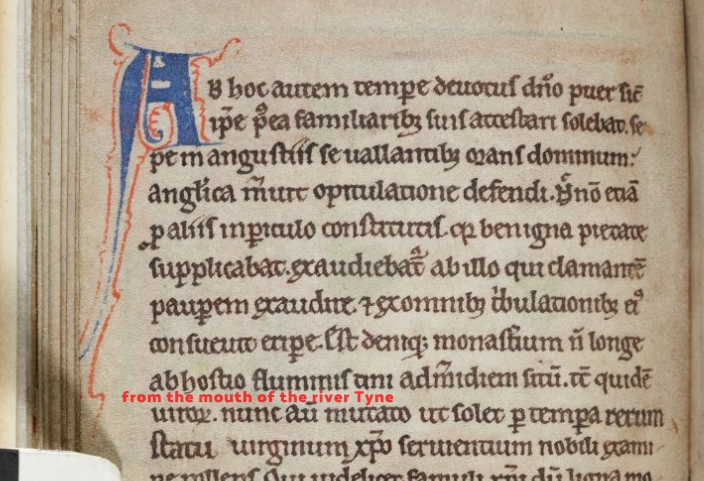
However, the oldest surviving manuscript of the Life of St Cuthbert dates from the mid 930’s (Corpus Christi College, Cambridge, MS183). Similarly the text states: ‘ab ostio tini flumins‘ – from the mouth of the Tyne River.
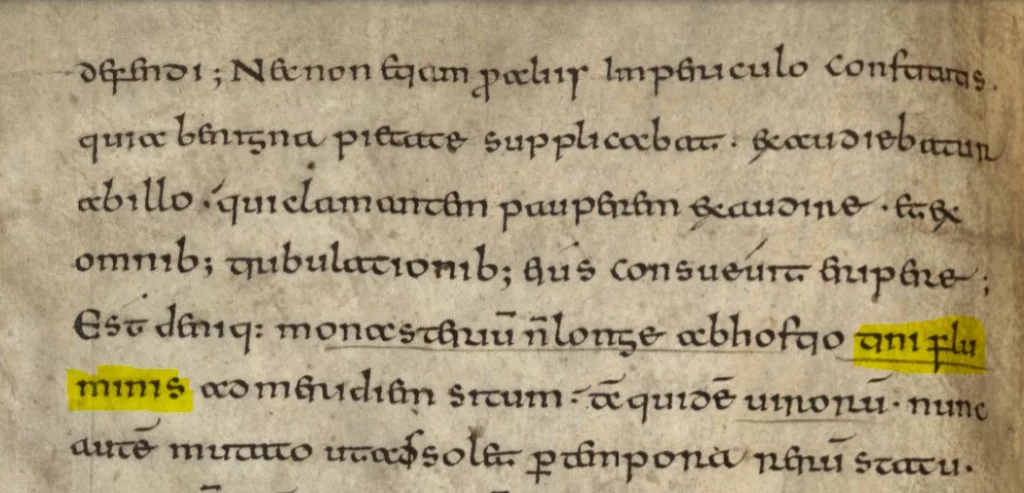
Bede’s most famous work was The Ecclesiastical History of the English People. The image below is from a copy written in the late 8th or early 9th century. Bede, writing at Jarrow, makes a mention of Tynemouth in so much as ‘the monastery next to the mouth of the River Tyne’, or in Latin: ‘monasterio, quod est juxta ostium tini fluminis.’ This is one of the earliest copies of his famous book (British Library Cotton MS Tiberius C II, f129.r) and is quite possibly the oldest surviving mention of Tynemouth as well as the earliest mention of the monsastery at Tynemouth.
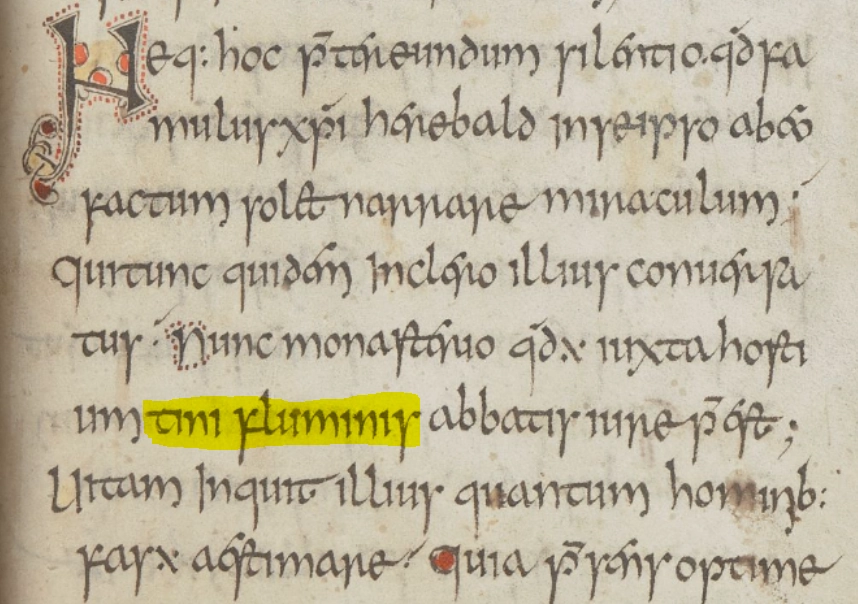
The Latin text reads as follows:
Neque hoc praetereundum silentio, quod
famulus Christi Herebald in seipso ab eo
factum solet narrare miraculum,
qui tunc quidem in clero illius conversatus,
nunc monasterio, quod est juxta ostium
tini fluminis, abbatis jure praeest.
Vitam inquit, illius quantum hominibus
aestimare fas est, quod, praesens optime.
Translated:
Nor do I think that this miracle,
which Herebald, the servant of Christ,
says was wrought upon himself by the bishop,
is to be passed over in silence. He was then one of that bishop’s clergy,
but now presides as abbot in the monastery at the mouth of the river Tyne.
“Living with him,” said he, “and being very well acquainted with his course of life,
I found it to be in all points worthy of a bishop, as far as it is lawful for men to judge;
Since this passage discusses the monastery at the mouth of the Tyne – it is presumably on Penbal Crag and a precursor to the ruined Priory that we see today. It is known that a Saxon church existed there and fragments of Saxon stone have occasionally been found. From this statement we can only assume that a collection of houses did exist in Tynemouth in the vicinity of the monastery, but perhaps were not enough to be considered a village in themselves.
In summary, the first mention of Tynemouth, or the “mouth of the River Tyne” was written by Bede in the Life of Saint Cuthbert, but since no original versions are known to exist, it appears the 8th century manuscript of Bede’s History of the English People, held by the British Museum, is the oldest surviving record we have of Tynemouth in history.
Listen to the audio for this post here:






